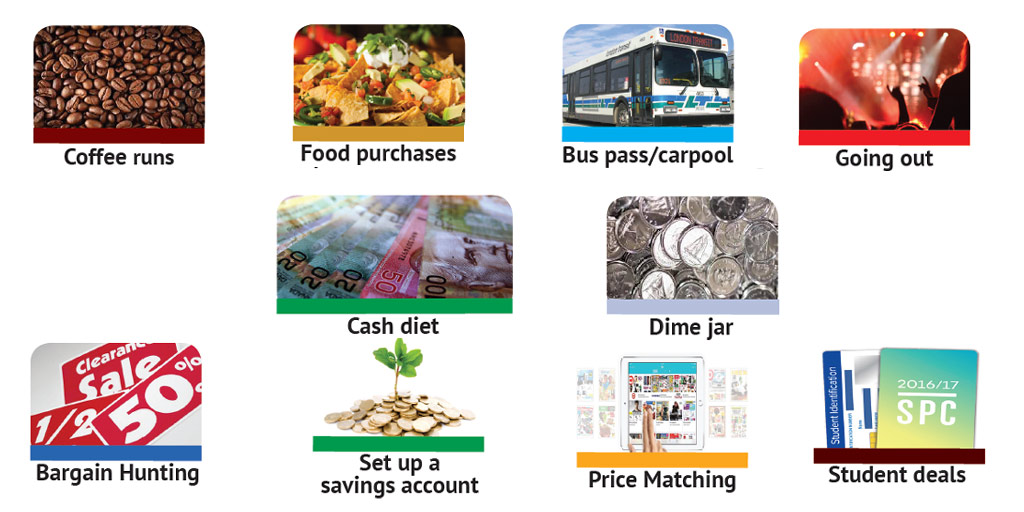Ten ways to save money this school year

Coffee runs
While those quick coffee or tea runs may seem cheap at the time, a month’s worth of even one cup per day can total approximately $60. By the end of the school year that’s almost $500. If you can’t go without your caffeine fix, the best thing to do is make your own home brew. Tea bag boxes at around $10 usually have an average of 200 teabags, which works out to be $0.05 per day. Even individual K-cups can be bought for approximately $0.70 at your local grocery store.
Food purchases
Being conscientious of the amount of fast food or “grab and go” meals you buy will not only have great benefits for your bank account, but also your health. Buying groceries each week and planning meals maximizes the amount of food you get for your money. By making homemade food, it also gives you the option of freezing the extras and making it last longer for when you don’t feel like making something.
Bus pass/carpool
Unfortunately, while an extra 20 minutes spent on a bus might be a drag, it’s a small price to pay (literally) compared to the amount of money you would spend on gas for your car. Your bus pass is incorporated into your tuition fee and because you can use it an unlimited amount of times, you can make it worth the money. Before long you could break even; heck, you could even make money off of the system that charges your bank account a crippling amount of money each year.
Going out
Going out is often one of the easiest ways to spend money in the shortest amount of time. The amount you spend using your debit or credit card can rack up fast, especially if you spend money on alcoholic beverages. The best advice would be to reduce the amount of times you go out and the amount of drinks you buy. Another tip on how to make your nights out cheaper include sharing a cab ride and dividing the total between you and your friend or assigning a designated driver that will remain sober.
Dime jar
You may have heard of “the dime jar challenge”. All you need is an empty two-litre bottle. Every time that you have some spare dimes, drop them in the bottle (this is when going on the cash diet is really helpful because you will rack up spare change, fast). Once the bottle is full, you should have approximately $500; this is a pretty great trick if you ask us. Expert tip: decorate the bottle to make it look eye-catching rather than a dreary, old bottle.
Set up a savings account
Setting up tax-free savings account is a simple way to save money with minimal effort. Every time you receive a direct deposit or on a certain day, an amount of your choice can be directed into your savings. When it is done automatically, before long you will have saved a large sum of money.
Bargain Hunting
By scouting out bargain stores such as Dollarama, often you can get the exact same product, even the same brand, but for much cheaper. Be wise though, some products you get what you pay for. You could also visit second- hand stores or make sure to only shop in stores during sales. Lastly, you can always reuse items at home and make DIY projects.
Price Matching
Price matching is a great way to find places with the best deals. Usually flyers are delivered through the mail or can be found on a company’s website or by using apps such as Flipp. Comparing different prices for the exact same items makes you feel so accomplished after shopping the best deals.
Student deals
A lot of grocery stores now have 10 per cent off days for students. By showing your student card, you can receive 10 per cent off your purchase. Ask in store or look online for the day of the week at each grocery store. Other sources of entertainment such as places where you can go watch a movie or go bowling also have deals on certain nights that you should check out.
Cash diet
One of the best ways to track how much you’re spending is by doing what is called a “cash diet”. It is exactly as it sounds: when you go to use money, you only use cash. By dividing up physical money it prevents you from constantly tapping into your bank account, which can quickly add up. The most efficient way to do this is by deciding how much you can afford and want to be spending each week on “extras”. After calculating how much you realistically are willing to spend each week, withdraw that amount of cash at the beginning of the week. That way, you know there is a limit to how much you spend and it makes you seriously consider what you want to invest your money in that week. Throw some self-control into the mix to help you not dip into your bank account and you’re set.














